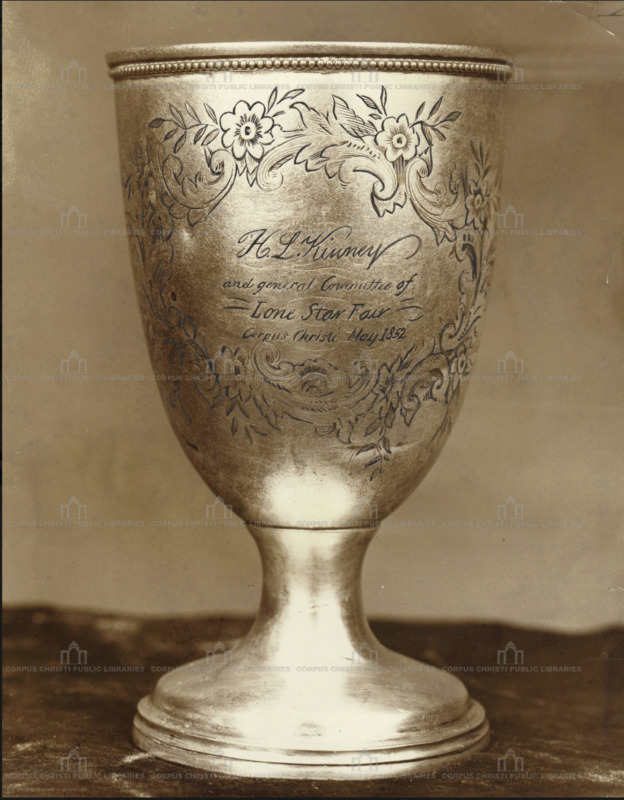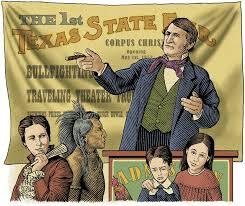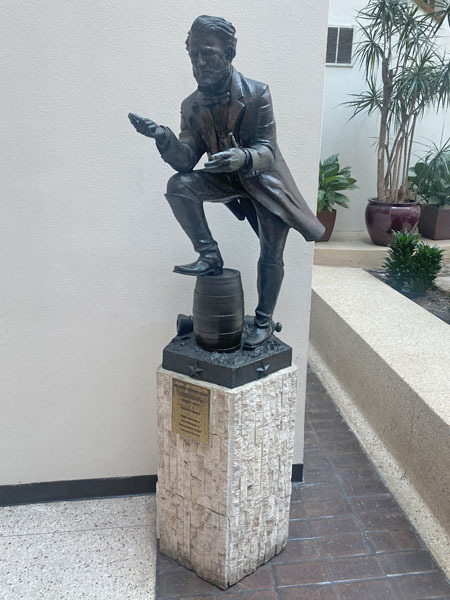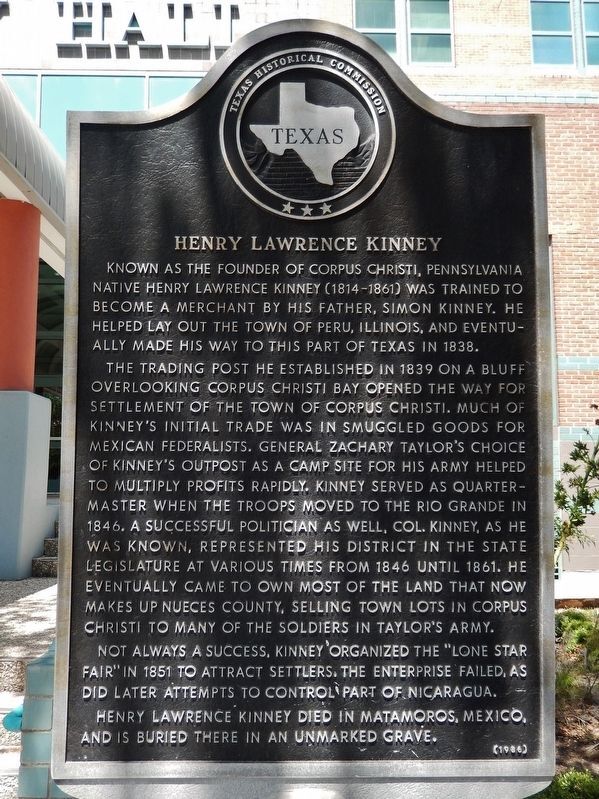Heritage and Hope: The 1852 Lone Star Fair

World’s Fairs began in the mid 1800s as a way to promote nationalism, trading, and gain settlement throughout the United States. Being such a large state with much to explore, Texas was no exception. Colonel Henry Lawrence Kinney founded the town of Corpus Christi, Texas. Corpus Christi is located off the Gulf of Mexico and provides fertile lands for crops and livestock, which led Colonel Kinney’s motivation to populate the area. In order to do so, he established the Lone Star Fair, which would take place on May 01, 1852. With his efforts, Corpus Christi would be promoted throughout the nation in hopes of gaining more settlers.
Corpus Christi at the time of its founding was a town used for trading purposes. Colonel Kinney landed in Corpus Christi in the late 1830s to establish a trading post used for smuggling goods for Mexican Federalists.[1] The fort-like trading post was enclosed by a stockade, containing Kinney’s home, store, and quarters for armed men. The bulk of Kinney’s trade was with Indians and smuggling for Mexican Federalists who were in constant conflict with Centralist forces. In the mid 1840s, Kinney’s business boomed as General Zachary Taylor’s army camped in the area and Kinney enlisted with Taylor as a quartermaster.[2]
What made Colonel Kinney so eager to establish settlement in Corpus Christi had much to do with its location and fertile lands. He put out an advertisement looking for families to settle the area in The Nueces Valley newspaper on May 25, 1850 stating, “The soil and climate are unsurpassed, water abundant, and a market for all that can be raised. There are three companies of rangers in the vicinity to protect the frontier, and Government is determined to establish permanent posts, so there may be no apprehension of future trouble with the Indians.”[3]
Colonel Kinney continuously worked towards his goals of creating a city out of Corpus Christi. He distributed 20,000 handbills in England which offered farmland for sale, cheap. These brought an influx of immigrants, including Robert and William Adams, and popular South Texas names including the Almomnds, Brydens, Reynolds, Wades, Wrights, all of whom would become prominent stock-raisers who came to farm and become sheep and cattle ranchers.[4] These early settlers of Corpus Christi would become historical names and figures that would help establish the land it later became as it reached city status.
There were mixed feelings about the self-established Colonel. Born in Pennsylvania, Henry was a merchant who helped lay out the town of Peru, Illinois. He arrived in Texas in 1839 on a bluff overlooking Corpus Christi Bay. Kinney’s outpost became a camp site for General Zachary Taylor’s army which helped to multiply his profits rapidly. He was a successful politician and represented his district in the state. He owned a lot of the land that is now Nueces County, and sold lots of land to the soldiers in Taylor’s army.[5] Others believed Kinney to be more concerned with settling the land in order to support General Jose M. J. Carbajal’s revolutionary movement in northern Mexico. He gained the reputation that “he was a man who thrived on war.”[6] He also had the reputation of being, “one of the most original and fearless of Texans…a loyal Texan, within the limits of his own code, who ruled a ‘town without a country.”[7] Overall, the attitude towards Kinney is he was a man willing to do what he needed to in order to achieve what he wanted. His efforts came at a more personal expense as he put his funds towards establishing the Lone Star Fair in 1852.
Colonel Kinney put much effort into bringing more settlers to the Corpus Christi effort. HIs most significant event was the Lone Star Fair in 1852. The Lone Star Fair was Colonel Kinney’s way of bringing people to the Corpus Christi area. It was reported that, “every movement in and around Corpus Christi, at the present time, seems to have come connexion with the Great Fair. The Republican went on to say that residents of the town were busily repairing their property, new buildings were being erected, and a race course was being laid out.”[8] Kinney was able to recruit many important individuals to the fair and gained funding from significant individuals such as John Peter Schatzell, who Kinney borrowed $45,000 to help pay for the event.[9] Some of the prominent figures that attended the fair included Gov. Bell, of Texas; Dr. Asbel Smith; Gen. Carvajal; Gen. H. McLeod, and many more.[10] The amusements and exhibits presented at the fair include the Cavello Opera, races, concerts, circus, bull fights, and the greatest sensation, the mule race.[11] Colonel Kinney expected close to 20,000 people to attend, and on the day of the fair on May 01, 1852, about 3,000 strangers were in town to see the horse races, bull fights, and cock-fighting. Maltby’s Circus put on nightly performances to an audience of frontiersman, Indians, American and Mexican ladies, and Mexican rancheros. There were displays of saddles, bridles, and blankets and agricultural and livestock exhibits, as well. An award for the finest cotton went to Kinney’s wife, Mary, for cotton grown on the Oso Gail Bordon. Gordon would also win a prize for his meat biscuit,[12] as did many others win prizes at the fair. Prizes were of three classes. The first class included a richly chased coffee urn, embossed cake basked, punch bowl, and numerous pitchers. The second class included silver waiters, sugar baskets, and milk pitchers. The third class listed sauce boats, cream pitchers, and a splendid assortment of Rich Goblets, Cups, Tumblers.[13]
Another notable event that occurred at the Lone Star fair included a speech by General Carjaval. A correspondent of the N. O. Delta says: “He was presented to the audience by Dr. Smith, who bespoke for him a patient hearing. In a clear and remarkably distinct voice he proceeded to set forth his cause, and that of the people of Tamaulipas, and the wrongs inflicted upon them by the tyranny and oppression of the Mexican Government. He certainly made out a strong and very aggravated case. His address was written with great force and beauty of language, and his appeals were very eloquent. He was warmly applauded throughout. The address occupies sixteen pages, and will be published.”
Gen. McLeod succeeded in a stirring address, in behalf of the same cause, and a great deal of enthusiasm seems to have followed.[14]
Overall, the turnout of the fair was not what Colonel Kinney had in mind, but there were many benefits to the Corpus Christi area because of it. People who would become famous in Texas history attended the fair, such as Rip Fod, Sally Skull, Legs Lewis, and Capt. Richard King.[15] The Galveston Gazette, speaking of the State Fair at Corpus Christi, says: Accounts from Corpus Christi are contradictory. Several hundred persons were in attendance; but while some parties represent things in a lively and agreeable light, others say that the society is for the most part, far from being select, and disorder the prominent feature of the entertainment.[16]
The attendance of the Lone Star Fair was not what was expected by Colonel Kinney. One contribution to this can be explained through, “the remoteness of its location. Travel was difficult and hazardous. Roads were few and unimproved. Overland travel was by horseback or covered wagon and oxcart. By sea, the voyage required a transfer from ocean-going steamers to small packet boats which doubled as fishing boats. The country was undeveloped and thinly settled. Bands of hostile Indians and Mexicans roamed the prairies, constantly raided the ranches around Corpus Christi, and left their victims mutilated and murdered.”[17]
Kinney put in many funds and borrowed from multiple individuals to help fund the fair. The aftermath would leave Kinney in economic ruin. He lost money on the venture and his creditors demanded payment.[18] Gen. Hugh McLeod obtained a judgment and took possession of Kinney’s Mustang Island ranch. Forbes Britton sued Kinney for money he owed him, after writing him a bitter letter demanding payment. Schatzel’s executor of his estate pressed Kinney to repay the loan he gave him and Kinney was forced to mortgage most of his holdings to repay the debt.[19] With the failure of the enterprise, as did [Kinney’s] later attempts to control part of Nicaragua. Henry Lawrence Kinney died in Matamoros, Mexico from a gunshot wound.[20]
As for the land of Corpus Christi, the population and land continued to grow and develop after the LoneStar Fair in 1852. The Nueces Valley speaks of the brisk business appearance of Corpus Christi since the fair. It says new buildings of a neat and substantial character are being erected, and the town is rapidly increasing in population.[21] Immigrants attracted here in 1852 became some of the region’s most influential settlers, here in Corpus Christi and in the sheep country of the Nueces Valley. Richard King, who owned a string of riverboats on the Rio Grande, came north to attend the fair; riding over a sea of rich knee-high grass. King got the idea of starting a ranch, it is believed, while he was camped one night by a little stream called the Santa Gertrudis.[22] King is just one of many examples of individuals that would be attracted to the rich and fertile lands of the land within Corpus Christi. Even though the fair was a failure in regards to Kinney’s intentions, the fair did bring attention to the land of Corpus Christi and increased interest in the area. By 1854 Corpus Christi's population reached 1,200, up from 698 county residents in 1850.[23]
Images





